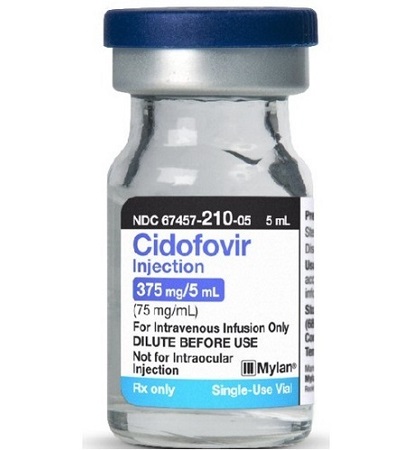Cidofovir Chemische Eigenschaften,Einsatz,Produktion Methoden
Beschreibung
Cidofovir launched as a first-line treatment for CMV retinitis in
AIDS patients. It is a nucleotide analog with potent activity against a broad spectrum
of DNA viruses, e.g., HSVl, HSV2, CMV, adenovirus and papillomavirus. Cidofovir
can be synthesized by a number of methods, the most efficient involves ring
openning of (R)-glycidol with cytosine. Metabolically, cidofovir does not require
intracellular activation by virally-encoded enzymes like similar compounds, e.g.,
aciclovir or ganciclovir. It is rapidly converted to its active form, cidofovir
diphosphate, which inhibits viral DNA polymerase at concentrations up to 600 fold
lower than that required for human DNA polymerase. It is a competitive inhibitor of
dCTP incorporation or if incorporated into viral DNA slows down further DNA
synthesis and causes the destabilization of the viral DNA. There are three
intracellular metabolites which are also active thus giving rise to the long half-life.
This results in lower dosing times (once every 1-2 weeks) and the ability to protect
previously uninfected cells from subsequent infection.
Verwenden
Cidofovir suppresses virus replication by selective inhibition of viral DNA synthesis.

Cidofovir, a monophosphorylated nucleotide analog, does not require viral thymidine kinase phosphorylation to act and therefore has activity against herpes simplex infections with deficient or altered thymidine kinase activity. It is ineffective against rare strains with mutations in DNA polymerase. It is administered intravenously, 5 mg/kg/week for acyclovir-resistant infections in immunocompromised hosts. Associated side effects include nephrotoxicity and neutropenia. Concomitant administration of cidofovir with probenecid and saline hydration decreases the nephrotoxicity. Cidofovir resistance has not been documented.
Definition
ChEBI: Cytosine substituted at the 1 position by a 3-hydroxy-2-(phosphonomethoxy)propyl group (S configuration). A nucleoside analogue, it is an injectable antiviral used for the treatment of cytomegalovirus (CMV) retinitis in AIDS patients.
Indications
Cidofovir (Vistide) is an acyclic phosphonate cytosine
analogue with activity against herpesviruses including
CMV, HSV-1, HSV-2, EBV, and VZV. It also inhibits
adenoviruses, papillomaviruses, polyomaviruses, and
poxviruses. Activation of cidofovir requires metabolism
to a diphosphate by host cellular enzymes. Because this
activation does not depend upon viral enzymes, similar
levels of cidofovir diphosphate are seen in infected and
uninfected cells. Cidofovir diphosphate competes with
deoxycytidine triphosphate (dCTP) for access to viral DNA polymerase and also acts as an alternative substrate.
The incorporation of one cidofovir molecule into
the growing DNA chain slows replication; sequential incorporation
of two molecules halts DNA polymerase
activity.
Antimicrobial activity
The phosphonate group enables it to mimic a nucleotide and
bypass virus-dependent phosphorylation. Cellular enzymes
convert it to the triphosphate, which has in-vitro and in-vivo
activity against CMV and other herpesviruses, including aciclovir-
resistant HSV. Oral hairy leukoplakia resolved on therapy,
suggesting that it has activity against EBV. Activity against
adenovirus and papillomaviruses is also reported.
Allgemeine Beschreibung
Cidofovir, (S)-3-hydroxy-2-phosphonomethoxypropyl cytosine(HPMPC, Vistide), is an acyclonucleotide analog thatpossesses broad-spectrum activity against several DNAviruses. Unlike other nucleotide analogs that are activated tonucleoside phosphates, Cidofovir is a phosphonic acid derivative.The phosphonic acid is not hydrolyzed by phosphatasesin vivo but is phosphorylated by cellular kinases to yield adiphosphate. The diphosphate acts as an antimetabolite to deoxycytosinetriphosphate (dCTP). Cidofovir diphosphate is acompetitive inhibitor of viral DNA polymerase and can beincorporated into the growing viral DNA strand, causingDNA chain termination.
Cidofovir possesses a high therapeutic index against CMVand has been approved for treating CMV retinitis in patientswith AIDS. Cidofovir is administered by slow, constant intravenousinfusion in a dose of 5 mg/kg over a 1-hour periodonce a week for 2 weeks. This treatment is followed by amaintenance dose every 2 weeks.
Hazard
A severe skin irritant.
Pharmazeutische Anwendungen
An acyclic cytosine analog administered by intravenous
infusion.
Mechanism of action
Cidofovir is a synthetic acyclic pyrimidine nucleotide analogue of cytosine. It is a phosphorylated
nucleotide that is additionally phosphorylated by host cell enzymes to its active intracellular metabolite,
cidofovir diphosphate. This reaction occurs without initial virus-dependent phosphorylation by viral
nucleoside kinases. It has antiviral effects by interfering with DNA synthesis and inhibiting viral
replication.
Pharmakokinetik
Oral absorption: <5%
C
max 3 mg/kg intravenous infusion: 7.7 mg/L end infusion
10 mg/kg intravenous infusion: 23 mg/L end infusion
Plasma half-life: c. 3–4 h
Volume of distribution: c. 0.6 L/kg
Plasma protein binding: <6%
The intracellular half-life of the diphosphate is 17–65 h. It
is excreted unchanged by the kidney by glomerular filtration
and tubular secretion.
Clinical Use
Cidofovir is approved for the treatment and prophylaxis
of CMV retinitis in AIDS patients. It has also been
used in the treatment of acyclovir-resistant (viral thymidine
kinase-deficient) HSV infections, polyomavirusassociated
progressive multifocal leukoencephalopathy,
condylomata acuminata (anogenital warts), and molluscum
contagiosum.
Nebenwirkungen
The most immediately serious adverse effect associated
with cidofovir therapy is nephrotoxicity. Accumulation
of the drug within the proximal tubule epithelial cells
can lead to proteinuria, azotemia, glycosuria, elevated
serum creatinine, and rarely, Fanconi’s syndrome.
Probenecid is administered along with cidofovir to
block its uptake into the proximal tubule epithelial cells
and thereby inhibit its tubular secretion as well as its
toxicity. Probenecid carries its own adverse effects, including
gastrointestinal upset, hypersensitivity reactions,
and a decrease in the elimination of drugs that
also undergo active tubular secretion (e.g. nonsteroidal
antiinflammatory drugs [NSAIDs], penicillin, acyclovir,
zidovudine).
Anterior uveitis and neutropenia are fairly common
side effects of cidofovir therapy. Ocular hypotony and
metabolic acidosis are rare. Exposure to therapeutic
levels of cidofovir causes cancer in rats; therefore, this
drug should be considered a potential human carcinogen.
Animal studies have also shown cidofovir to produce
embryotoxic and teratogenic effects and to impair
fertility.
Cidofovir Upstream-Materialien And Downstream Produkte
Upstream-Materialien
Downstream Produkte

